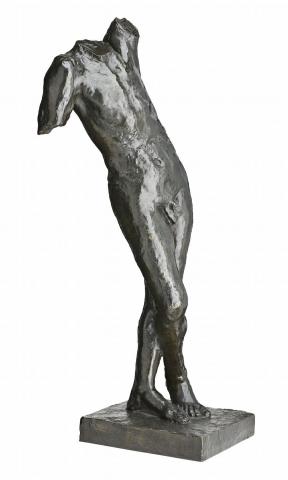SPIRIT OF ETERNAL REPOSE (LE GENIEDU REPOS ETERNEL, SANS TETE ET BRAS), c.1898 and cast in 1980
Auguste Rodin
bronze with brown patina
86.0 cm height
signed on top of base: A. Rodin
inscribed on front of base: 7/8
inscribed on front of base: © by Musée Rodin, 1980
stamped with foundry mark on back of base
Accompanied by a Certificate of Authenticity, signed by Monique Laurent, Chief Curatorat the Musée Rodin, 1985
Musée Rodin, Paris
David Jones Art Gallery, Sydney
Acquired from the above by Mr Neville Gruzman, Sydney, 1988
In 1899, a committee of the Societe nationale des beaux-arts commissioned Rodin to create a monument in honour of the acclaimed French symbolist painter Puvis de Chavannes, to be located in the new Paris square of Cluny.
Although untiring in his devotion to Puvis and the poetic, evocative simplicity of his art - he would later praise the painter on his own deathbed - Rodin received the commission reluctantly, as he was already overcommitted to monumental projects and perhaps more poignantly, was still inwardly suffering from the disastrous experience ensuing from his proposed Monument to Balzac the previous year. Notwithstanding, he ultimately accepted, proposing the monument as a synthesis of 'readymades' - the bust of the painter from 1890-91 and the present Spirit of Eternal Repose, completed at least a year earlier, to whose body Rodin was to add a head and arms. The rest - an architectural capital, a table and the large branch of an apple tree - would derive from his studio and garden.
Describing the monument from an assemblage in the sculptor's studio, contemporary Camille Mauclair commented in 1905: 'Instead of making the customary statue, [Rodin] considered the purely Greek quality of Puvis' genius and chose to pay homage to him in a form reproduced from the antique. The bust of the great painter is placed on a plain table, as the ancients placed their dead upon little domestic altars. A fine tree loaded with fruit bends over and shades the head. Leaning on the table behind the bust is a beautiful naked youth, who sits [sic.] dreaming in a well-chosen supple attitude.'1 Thus reinvigorating classical prototypes which featured the muses or Apollo paying tribute to a poet, Rodin here envisages the allegorical figure of the Spirit (Apollo) plucking a golden apple for Puvis as a symbol of eternal life.
While bearing striking affinities with Greek sculpture - in particular, the marbles of Pothos (Longing) in the Uffizi, Florence and Paris in Landsdowne House, England (both of which Rodin would have known) - the adolescent model's hipshot pose with crossed-over leg is, significantly, unprecedented in the long history of figure sculpture. Not only does it violate the ancient Greek tradition of a self-balancing figure that resists gravity by its uprightness but, perhaps more controversially, the pose subverted the French academic convention of having a standing figure plumb, the head on a vertical axis above the foot that carries the body's weight.2 Arguably as controversial as the novelty of the figure's vertigo-inducing posture however, was the 'deliberately flawed' surface facture of the sculpture - varying from large areas of a granular texture, to undisguised mashed pellets of clay, to the fluid, sensuous evocation of flesh on the figure's left leg and thigh.
Sadly, by 1914 the figure of the Spirit had still not progressed beyond saumon (the roughed-out stage in stone). As with his other unfinished monuments, Rodin seems not to have discussed the reasons for its incompletion, although commentators have subsequently posited that he was incapable of thinking in monumental terms; that he was too self-critical and dedicated to revitalising the public monument; or simply, that the committee lacked sufficient funds or consensus as to the monument's proposed location.3 Whatever the explanation, it is undisputed that Rodin considered the Spirit of Eternal Repose among his finest achievements, for not only did he include a plaster version in the touring exhibition of 1899 (which travelled all over Europe and to Philadelphia during the last two years of the century), but he exhibited it twice in his major solo retrospective of 1900.
1. Mauclair, C., Rodin: The Man - His Ideas - His Works, Duckworth & Co., London, 1905, p. 89
2. Elsen, A. E. et al., Rodin's Art: The Rodin Collection, Iris and B. Gerald Cantor Center for Visual Arts at Stanford University, Stanford University with Oxford University Press, New York, 2003, p. 344.
3. ibid., pp. 338-9
VERONICA ANGELATOS
